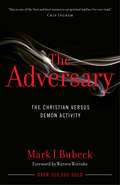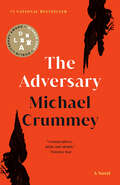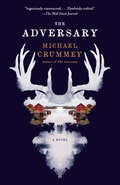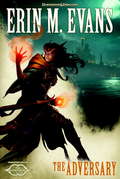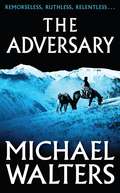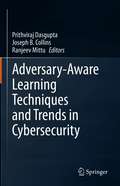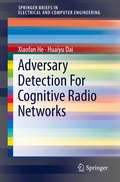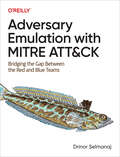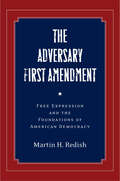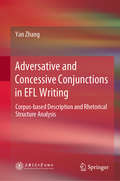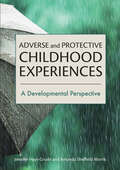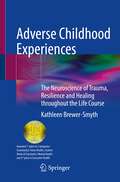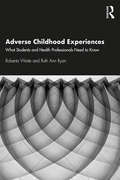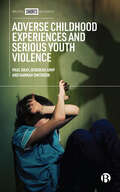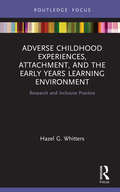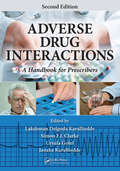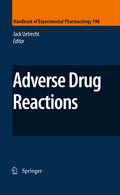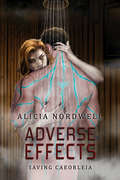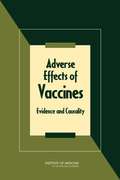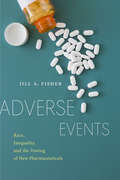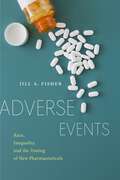- Table View
- List View
The Adversary: The Christian Versus Demon Activity
by Mark I. BubeckSpiritual warfare is real, and we are all involved whether we like it or not.The Bible plainly tells us that Satan schemes against humanity and that he wants to devour us. Daily we struggle against Satan's strategies and desire to take over God&’s kingdom. This battle will not go away, and ignoring it could be disastrous. But don't be afraid. The victory is already won by Christ. No enemy is powerful enough to overcome the risen savior. In these pages, Mark Bubeck exposes the reality of the conflict and the hope believers have. He answers such questions as: What is Satan's strategy in spiritual warfare? Can a Christian be oppressed by demons? Can demonic affliction be passed down through family lines? What are the symptoms of demonic activity in a person's life? Having sold more than 350,000 copies worldwide, this bestseller will help the reader triumph in the battle against demonic activity by relying on the almighty and powerful Son of God.
The Adversary: The Christian Versus Demon Activity
by Mark I. BubeckSpiritual warfare is real, and we are all involved whether we like it or not.The Bible plainly tells us that Satan schemes against humanity and that he wants to devour us. Daily we struggle against Satan's strategies and desire to take over God&’s kingdom. This battle will not go away, and ignoring it could be disastrous. But don't be afraid. The victory is already won by Christ. No enemy is powerful enough to overcome the risen savior. In these pages, Mark Bubeck exposes the reality of the conflict and the hope believers have. He answers such questions as: What is Satan's strategy in spiritual warfare? Can a Christian be oppressed by demons? Can demonic affliction be passed down through family lines? What are the symptoms of demonic activity in a person's life? Having sold more than 350,000 copies worldwide, this bestseller will help the reader triumph in the battle against demonic activity by relying on the almighty and powerful Son of God.
The Adversary: A Novel
by Michael CrummeyFrom the award-winning, bestselling author of The Innocents, a dark, enthralling novel about love and its limitations, the corruption of power and the power of corruption.In an isolated outport on Newfoundland's northern coastline, Abe Strapp is about to marry the daughter of a rival merchant to cement his hold on the shore when the Widow Caines arrives to throw the wedding and Abe's plans into chaos. That ruthless act of sabotage is the opening salvo in a battle between the man and woman who own Mockbeggar's largest mercantile firms, each fighting for the scarce resources of the north Atlantic fishery, each seeking a measure of revenge on the person they despise most in the world. As their unshakeable animosity spirals further each year into vendettas and violence, the community is increasingly divided and even the innocents in Mockbeggar find themselves forced to take sides, with devastating consequences. Through merciless seasons of uncertainty and want, through predatory storms and pandemics and marauding privateers, it is the human heart that reveals itself to be the most formidable and unpredictable adversary for each person drawn, inevitably and helplessly, into that endless feud. Compulsively readable and uncompromising, The Adversary is a pitch-perfect evocation of a lost time, and a shadowed mirror to our modern politics of grievance and retribution. It is Michael Crummey's finest novel to date.
The Adversary: A Novel
by Michael CrummeyLONGLISTED FOR THE DUBLIN LITERARY AWARDAn enthralling novel about the corruption of power and the power of corruption from the award-winning, bestselling author of The Innocents"POTENT...A VIBRANT HISTORICAL NARRATIVE"—The New Yorker"A FLAWLESSLY CRAFTED NARRATIVE" —Wall Street Journal"MASTERPIECE" —Publisher's Weekly (Starred Review)"CEASELESSLY ENTERTAINING" —Kirkus (Starred Review)"ONE OF OUR BEST WRITERS" —Booklist (Starred Review)In an isolated outport on Newfoundland's northern coastline, Abe Strapp is about to marry the daughter of a rival merchant to cement his hold on the shore when the Widow Caines arrives to throw the wedding and Abe's plans into chaos.That ruthless act of sabotage is the opening salvo in a battle between the man and woman who own Mockbeggar's largest mercantile firms, each fighting for the scarce resources of the north Atlantic fishery, each seeking a measure of revenge on the person they despise most in the world. As their unshakeable animosity spirals further each year into vendettas and violence, the community is increasingly divided and even the innocents in Mockbeggar find themselves forced to take sides, with devastating consequences. Through merciless seasons of uncertainty and want, through predatory storms and pandemics and marauding privateers, it is the human heart that reveals itself to be the most formidable and unpredictable adversary for each person drawn, inevitably and helplessly, into that endless feud. Compulsively readable and uncompromising, The Adversary is a masterful evocation of a lost time, and a shadowed mirror to our modern politics of grievance and retribution.
The Adversary
by Erin M. EvansIn this third book of the Sundering series kicked off by R.A. Salvatore and the dark elf Drizzt, SCRIBE award-winning author Erin M. Evans thrusts her signature character Farideh into a maelstrom of devilish politics and magical intrigue that will have far-reaching implications for the future of the Forgotten Realms.As the chaos of the Sundering rages around her, young warlock Farideh faces a more personal turmoil wrought by a deal she made with a devil years ago. Hoping to protect her twin sister, she leaves everything she holds dear to assist a wizard in a scheme that pits the devils of the Nine Hells against the gods above. But when Farideh casts the spell to enter the wizard's remote mountaintop fortress, she picks up a stowaway--a Harper agent named Dahl who isn't so inclined to follow devilish demands. Dahl attempts to escape only to run into a village of odd people, lurking behind an impenetrable wall. Forced to gaze into the villagers' souls, Farideh points out the ones who seem different, only to watch as the wizard's guard carts them off to fates unknown. Are these villagers or prisoners? Are they blessed or doomed by the gods? As the wizard's guessing game proves more and more diabolical, Farideh resolves to unravel his secrets--even if it means she'll lose her own soul to the Nine Hells.From the Hardcover edition.
ADVERSARY: Saga Of The Exiles: Book Four (The Saga of Pliocene Exile #4)
by Julian MayThe fourth and culminating volume in Julian May's dazzling quartet of science-fiction novels brings to a climax the struggle for the Many-Colored Land--the Earth six million years ago--and completes the series that has become an international best-seller and multiple award nominee. Human time-travelers from the sophisticated Galactic Milieu of the twenty-second century came to the Pliocene Epoch seeking a Garden of Eden. What they found was slavery under the knightly Tanu race, who had been exiled to Earth from a far galaxy. Freed by the usurper Aiken Drum, the humans enjoy a brief period of dominance. But now King Aiken's rule is threatened by the dwarfish Firvulag, who scheme to destroy both humans and Tanu in the nightfall War, a ritual Gotterdammerung that had been postponed when Tanu and Firvulag were banished to Pliocene Earth. This menace becomes almost incidental when Aiken discovers that his realm is about to be invaded by another human who possesses metapsychic powers even greater than Aiken's own. He is Marc Remillard, the Adversary, instigator of the Metapsychic Rebellion, who nearly conquered the Milieu, and then fled through the time-gate after his defeat. Marc and his surviving followers come against Aiken when it seems that a new time-gate is about to be built--one that will provide a two-way portal between the Many-Colored Land and the future world of the Milieu. The Adversary, like its predecessors (The Many-Colored Land, The Golden Tore, and The Nonborn King), combines science and fantastic imagery with rousing adventure, humor, and an optimistic view of the human character as it contends against mental and physical perils.
The Adversary
by Michael WaltersFor more than twenty years a hidden hand has ruled the backstreets of Ulan Baatar, but now Muunokhoi, the once untouchable head of the Mongolia's largest and most powerful criminal empire, has finally been caught.It should be the Serious Crime Team's finest hour. But nothing is ever that simple in the new Mongolia. Ineptitude and petty corruption have dogged the department for years, but when Muunokhoi's trial starts to collapse, Nergui and Doripalam--the ex-head of the Team and his one-time protege--are forced to acknowledge that something truly rotten lies at the heart of the organization they have dedicated their lives to. With the crime lord's acquittal impending, and his revenge a cold certainty, Nergui and Doripalam are not even sure they can trust each other.In The Adversary, Michael Walters returns to industrial ruins of Ulan Baatur and the bleak emptiness of the Mongolian steppes in a tense battle between a master criminal and the men determined to bring him to justice.
Adversary-Aware Learning Techniques and Trends in Cybersecurity
by Prithviraj Dasgupta Joseph B. Collins Ranjeev MittuThis book is intended to give researchers and practitioners in the cross-cutting fields of artificial intelligence, machine learning (AI/ML) and cyber security up-to-date and in-depth knowledge of recent techniques for improving the vulnerabilities of AI/ML systems against attacks from malicious adversaries. The ten chapters in this book, written by eminent researchers in AI/ML and cyber-security, span diverse, yet inter-related topics including game playing AI and game theory as defenses against attacks on AI/ML systems, methods for effectively addressing vulnerabilities of AI/ML operating in large, distributed environments like Internet of Things (IoT) with diverse data modalities, and, techniques to enable AI/ML systems to intelligently interact with humans that could be malicious adversaries and/or benign teammates. Readers of this book will be equipped with definitive information on recent developments suitable for countering adversarial threats in AI/ML systems towards making them operate in a safe, reliable and seamless manner.
Adversary Detection For Cognitive Radio Networks (Springerbriefs In Electrical And Computer Engineering)
by Xiaofan He Huaiyu DaiThis SpringerBrief provides a comprehensive study of the unique security threats to cognitive radio (CR) networks and a systematic investigation of the state-of-the-art in the corresponding adversary detection problems. In addition, detailed discussions of the underlying fundamental analytical tools and engineering methodologies of these adversary detection techniques are provided, considering that many of them are quite general and have been widely employed in many other related fields.
Adversary Emulation with MITRE ATT&CK
by Drinor SelmanajBy incorporating cyber threat intelligence, adversary emulation provides a form of cybersecurity assessment that mimics advanced persistent threat (APT) tactics, techniques, and procedures (TTPs). This comprehensive guide introduces an empirical approach with strategies and processes collected over a decade of experience in the cybersecurity field. You'll learn to assess resilience against coordinated and stealthy threat actors capable of harming an organization.Author Drinor Selmanaj demonstrates adversary emulation for offensive operators and defenders using practical examples and exercises that actively model adversary behavior. Each emulation plan includes different hands-on scenarios, such as smash-and-grab or slow-and-deliberate. This book uses the MITRE ATT&CK knowledge base as a foundation to describe and categorize TTPs based on real-world observations, and provides a common language that's standardized and accessible to everyone.You'll learn how to:Map Cyber Threat Intelligence to ATT&CKDefine Adversary Emulation goals and objectivesResearch Adversary Emulation TTPs using ATT&CK knowledge basePlan Adversary Emulation activityImplement Adversary tradecraftConduct Adversary EmulationCommunicate Adversary Emulation findingsAutomate Adversary Emulation to support repeatable testingExecute FIN6, APT3, and APT29 emulation plans
The Adversary First Amendment: Free Expression and the Foundations of American Democracy
by Martin H. RedishThe Adversary First Amendment presents a unique and controversial rethinking of modern American democratic theory and free speech. Most free speech scholars understand the First Amendment as a vehicle for or protection of democracy itself, relying upon cooperative or collectivist theories of democracy. Martin Redish reconsiders free speech in the context of adversary democracy, arguing that individuals should have the opportunity to affect the outcomes of collective decision-making according to their own values and interests. Adversary democracy recognizes the inevitability of conflict within a democratic society, as well as the need for regulation of that conflict to prevent the onset of tyranny. In doing so, it embraces pluralism, diversity, and the individual growth and development deriving from the promotion of individual interests. Drawing on previous free speech scholarship and case studies of controversial speech, Redish advances a theory of free expression grounded in democratic notions of self-promotion and controlled adversary conflict, making a strong case for its application across such areas as commercial speech, campaign spending, and anonymous speech.
Adversative and Concessive Conjunctions in EFL Writing: Corpus-based Description and Rhetorical Structure Analysis
by Yan ZhangThis book explores the usage patterns of a group of adversative and concessive conjunctions in English texts written by Chinese EFL learners and their native speaker counterparts. Focusing on probability profiles and systemic potentials, the study encompasses three stages and combines the strengths of two research methods – the corpus-based approach and text-based analysis – to examine the conjunctions under the theoretical framework of systemic functional linguistics and rhetorical structure theory. Starting with an overview of seventeen conjunctions across two corpora in terms of overall frequency, positional distribution and distribution of semantic categories, the book then offers a more detailed discussion of three individual conjunctions, highlighting the interconnections between 1) syntactic positions and co-occurrence patterns and 2) semantic relations encoded by these conjunctions. Lastly, it presents a case study of one full-length text taken from the learner corpus, applying rhetorical structure theory to provide new insights into the relevance of adversative and concessive relations to text structure. This comprehensive, in-depth analysis is both diagnostic and pedagogically informative.
Adverse and Protective Childhood Experiences: A Developmental Perspective
by Jennifer Hays-Grudo Amanda Sheffield Morris PhDAdverse childhood experiences (ACEs) can negatively influence development. However, the lifelong effects of positive childhood experiences (PACEs) can mitigate the detrimental effects of adverse ones. By integrating existing knowledge about (ACEs) with developmental research on preventing, buffering, and treating the effects of adversity, stress, and trauma on child development and subsequent health and functioning, this book identifies the most important of these (PACEs). It provides an interdisciplinary lens from which to view the multiple types of effects of enduring childhood experiences, and recommends evidence-based approaches for protecting children and repairing the enduring negative consequences of (ACEs) they face as adults. Students, researchers, clinicians, and health-care providers can use this research to understand the science of early life adversity, lifelong resilience, and related intervention and prevention programming to help those suffering from the lifelong effects of (ACEs). Chapters include many figures, graphs, diagrams, stories, and activities that aim to help readers apply the science to everyday life.
Adverse Childhood Experiences: The Neuroscience of Trauma, Resilience and Healing throughout the Life Course
by Kathleen Brewer-SmythThe entire world is in crisis with adverse childhood experiences (ACEs) and other lifetime trauma at an all-time high. This book is a valuable resource to promote optimal brain function for everyone, but especially for survivors of trauma who are particularly at risk throughout the life course. It is critical for healthcare providers, schoolteachers and administration, public safety professionals, foster and adoptive parents, employers and loved ones to understand the potential life-long consequences that ACEs can have in the lives of survivors. This book describes the complexities behind why behaviors occur if hurt people hurt themselves and others. The first half of this book addresses what can go wrong in the brain and body after trauma that potentially leads to life-long poor bio-behavioral health outcomes. The second half of this book addresses how the life-long poor bio-behavioral health outcomes can be prevented, mitigated or potentially reversed. This book is necessary for everyone who is interested in optimizing brain function, especially survivors of ACEs and other trauma throughout the life course who are at greater risk. The major focus of the book is on how to prevent long-term negative consequences of trauma and how to restore the brain, body, behavior and emotions.
Adverse Childhood Experiences: What Students and Health Professionals Need to Know
by Roberta Waite Ruth Ann RyanThis guide provides healthcare students and professionals with a foundational background on adverse childhood experiences (ACEs) – traumatic early life experiences, which can have a profound impact on health in later life. ACEs can include being a victim of abuse, neglect or exposure to risk in the home or community. How healthcare students and professionals learn to recognize, react and respond to persons affected by trauma will lay the foundation for their relationships with patients. This book intentionally uses micro-to-macro lenses accompanied by a structural competency framework to elucidate health implications across the lifespan. It explores the nature of adversity and its effects on the physical, emotional, cognitive and social health of individuals, communities and society. The book, written by two experienced psychiatric nurses, will equip healthcare students and professionals with an understanding for critical change in practice and offer action steps designed to assist them with prevention and intervention approaches and steps to help build resilience. This book will be core reading for healthcare students within mental health, pediatric and primary care nursing courses. It will also be of interest to students and professionals in the social work, psychology and public health fields who are exploring resilience and trauma-informed practices
Adverse Childhood Experiences and Serious Youth Violence
by Paul Gray Deborah Jump Hannah SmithsonWhereas crime more generally has fallen over the last 20 years, levels of serious youth violence remain high. This book presents innovative research into the complex relationship between adverse childhood experiences and serious youth violence. While the implementation of trauma-informed approaches to working with adolescents in the justice system is becoming common practice, there remains a dearth of research into the efficacy of such approaches. Foregrounding young people’s voices, this book explores the theoretical underpinnings of trauma and the manifestations of childhood adversity. The authors conclude by advocating for a more psychosocial approach to trauma-informed policy and practice within the youth justice system.
Adverse Childhood Experiences, Attachment, and the Early Years Learning Environment: Research and Inclusive Practice
by Hazel G. WhittersAdverse Childhood Experiences, Attachment, and the Early Years Learning Environment explores the concept of learning by presenting research and illustrations from practice on three major topics: adverse childhood experiences, attachment, and environment. Each child has a unique reaction to adversity in the early years, and the book discusses the effect upon approach and avoidance motivation for learning, and the rationale of trauma-informed practice. The influence from a secure attachment figure is explored, and links between emotions and involvement are presented. The book highlights the current indoor and outdoor use of natural green spaces as a response to attention-fatigue and promotes comprehension of the issues in a context of attention restoration theory. Intervention for extended families is presented as an approach to supporting development and attainment in each generation, and to achieving a legacy beyond the professional network. This book will appeal to academics, researchers, and postgraduate students in the fields of early years care and education. It will also appeal to those working within children’s services.
Adverse Cutaneous Drug Reactions to Cardiovascular Drugs
by Esen Özkaya Kurtuluş Didem YazganoğluAdverse cutaneous drug reactions (ACDR) are among the most frequent events in patients receiving drug therapy. Cardiovascular (CV) drugs are an important group of drugs with potential risk of developing ACDR especially in elderly as marketing of more new drugs and their prescription continue to increase. However, like with most other drugs the exact incidence of cutaneous side effects from CV drugs is difficult to estimate due to sporadic reporting. Moreover, a reliable designation of a certain drug as the cause of a certain type of reaction can rarely be made. Apart from the well-known angioedema/urticaria from ACE inhibitors, lichen planus / lichenoid reaction from beta adrenergic blockers and photosensitivity from thiazid diuretics, ACDR from CV drugs might be seen in a wide spectrum extending to rare but life-threatening conditions such as erythroderma, Stevens-Johnson syndrome, toxic epidermal necrolysis or drug hypersensitivity syndrome. In this comprehensive review, the reported types of ACDR to CV drugs will be discussed according to drug class and the type of dermatologic reaction with special emphasize on cross-reactions and the role of patch testing in diagnosis.
Adverse Drug Event Reporting: The Roles Of Consumers And Health-care Professionals
by Institute of Medicine of the National AcademiesThe National Academies Press (NAP)--publisher for the National Academies--publishes more than 200 books a year offering the most authoritative views, definitive information, and groundbreaking recommendations on a wide range of topics in science, engineering, and health. Our books are unique in that they are authored by the nation's leading experts in every scientific field.
Adverse Drug Interactions: A Handbook for Prescribers, Second Edition
by Simon Clarke Ursula Gotel nee Collignon Janaka Karalliedde Lakshman KarallieddeAdverse Drug Interactions: A Handbook for Prescribers assists clinicians by providing key information on potential adverse effects that can result from prescribing two or more drugs for simultaneous use. Interactions that are likely to give rise to life-threatening conditions, and which must therefore be completely avoided, are clearly highlighted.
Adverse Drug Reactions (Handbook of Experimental Pharmacology #196)
by Jack UetrechtThis book provides the current state of knowledge of basic mechanisms of adverse drug reactions (ADRs). The main focus is on idiosyncratic drug reactions because they are the most difficult to deal with. It starts with a general description of the major targets for ADRs followed by a description of what are presently believed to be mediators and biochemical pathways involved in idiosyncratic drug reactions. There is also a description of several examples of ADRs that serve to illustrate specific aspects of ADR mechanisms. Eventually the book shows that ultimately better methods are needed to predict which drug candidates are likely to cause ADRs and which patients are at increased risk. But at present research seems to be far from this goal.
Adverse Effects (Saving Caeorleia #2)
by Alicia NordwellSaving Caeorleia: Book TwoDade, human-Caeorleian hybrid and ex-military grunt, doesn't fit in--not with humans, not with aliens, not anywhere. He's always on the outskirts, angry, and people aren't sure they can trust him. When he encounters a compatible tziu named Yaseke, secrets, misunderstandings, and attacks nearly prevent the two from making a connection Dade sorely needs. Even after they unite, Dade and Yaseke face challenges that two newly joined males should never have to endure. From traitorous council members, to sadistic aliens who plan to sell them as slaves, to meeting a mysterious race of revered aliens called Collectors, Dade and Yaseke manage to stay together--and even rescue two youths related to Yaseke, who've lost their parents to the same betrayer. Someone from Dade's past is at the root of everything he's suffered. No way can he let them get away with what they're planning, but Dade isn't sure he can stop them on his own. If he doesn't let go of his isolation and risk the pain letting others in will bring, he'll never save Caeorleia in time.
Adverse Effects of Vaccines
by Committee to Review Adverse Effects of VaccinesIn 1900, for every 1,000 babies born in the United States, 100 would die before their first birthday, often due to infectious diseases. Today, vaccines exist for many viral and bacterial diseases. The National Childhood Vaccine Injury Act, passed in 1986, was intended to bolster vaccine research and development through the federal coordination of vaccine initiatives and to provide relief to vaccine manufacturers facing financial burdens. The legislation also intended to address concerns about the safety of vaccines by instituting a compensation program, setting up a passive surveillance system for vaccine adverse events, and by providing information to consumers. A key component of the legislation required the U. S. Department of Health and Human Services to collaborate with the Institute of Medicine to assess concerns about the safety of vaccines and potential adverse events, especially in children. Adverse Effects of Vaccines reviews the epidemiological, clinical, and biological evidence regarding adverse health events associated with specific vaccines covered by the National Vaccine Injury Compensation Program (VICP), including the varicella zoster vaccine, influenza vaccines, the hepatitis B vaccine, and the human papillomavirus vaccine, among others. For each possible adverse event, the report reviews peer-reviewed primary studies, summarizes their findings, and evaluates the epidemiological, clinical, and biological evidence. It finds that while no vaccine is 100 percent safe, very few adverse events are shown to be caused by vaccines. In addition, the evidence shows that vaccines do not cause several conditions. For example, the MMR vaccine is not associated with autism or childhood diabetes. Also, the DTaP vaccine is not associated with diabetes and the influenza vaccine given as a shot does not exacerbate asthma. Adverse Effects of Vaccines will be of special interest to the National Vaccine Program Office, the VICP, the Centers for Disease Control and Prevention, vaccine safety researchers and manufacturers, parents, caregivers, and health professionals in the private and public sectors.
Adverse Events: Race, Inequality, and the Testing of New Pharmaceuticals (Anthropologies of American Medicine: Culture, Power, and Practice)
by Jill A. FisherExplores the social inequality of clinical drug testing and its effects on scientific resultsImagine that you volunteer for the clinical trial of an experimental drug. The only direct benefit of participating is that you will receive up to $5,175. You must spend twenty nights literally locked in a research facility. You will be told what to eat, when to eat, and when to sleep. You will share a bedroom with several strangers. Who are you, and why would you choose to take part in this kind of study? This book explores the hidden world of pharmaceutical testing on healthy volunteers. Drawing on two years of fieldwork in clinics across the country and 268 interviews with participants and staff, it illustrates how decisions to take part in such studies are often influenced by poverty and lack of employment opportunities. It shows that healthy participants are typically recruited from African American and Latino/a communities, and that they are often serial participants, who obtain a significant portion of their income from these trials. This book reveals not only how social inequality fundamentally shapes these drug trials, but it also depicts the important validity concerns inherent in this mode of testing new pharmaceuticals. These highly controlled studies bear little resemblance to real-world conditions, and everyone involved is incentivized to game the system, ultimately making new drugs appear safer than they really are. Adverse Events provides an unprecedented view of the intersection of racial inequalities with pharmaceutical testing, signaling the dangers of this research enterprise to both social justice and public health.
Adverse Events: Race, Inequality, and the Testing of New Pharmaceuticals (Anthropologies of American Medicine: Culture, Power, and Practice #9)
by Jill A. FisherWinner, 2022 Donald W. Light Award for Applied Medical Sociology, given by the Medical Sociology Section of the American Sociological AssociationWinner, 2021 Robert K. Merton Book Award, given by the Science, Knowledge, and Technology Section of the American Sociological Association2021 Outstanding Academic Title, Choice MagazineExplores the social inequality of clinical drug testing and its effects on scientific resultsImagine that you volunteer for the clinical trial of an experimental drug. The only direct benefit of participating is that you will receive up to $5,175. You must spend twenty nights literally locked in a research facility. You will be told what to eat, when to eat, and when to sleep. You will share a bedroom with several strangers. Who are you, and why would you choose to take part in this kind of study? This book explores the hidden world of pharmaceutical testing on healthy volunteers. Drawing on two years of fieldwork in clinics across the country and 268 interviews with participants and staff, it illustrates how decisions to take part in such studies are often influenced by poverty and lack of employment opportunities. It shows that healthy participants are typically recruited from African American and Latino/a communities, and that they are often serial participants, who obtain a significant portion of their income from these trials. This book reveals not only how social inequality fundamentally shapes these drug trials, but it also depicts the important validity concerns inherent in this mode of testing new pharmaceuticals. These highly controlled studies bear little resemblance to real-world conditions, and everyone involved is incentivized to game the system, ultimately making new drugs appear safer than they really are. Adverse Events provides an unprecedented view of the intersection of racial inequalities with pharmaceutical testing, signaling the dangers of this research enterprise to both social justice and public health.
